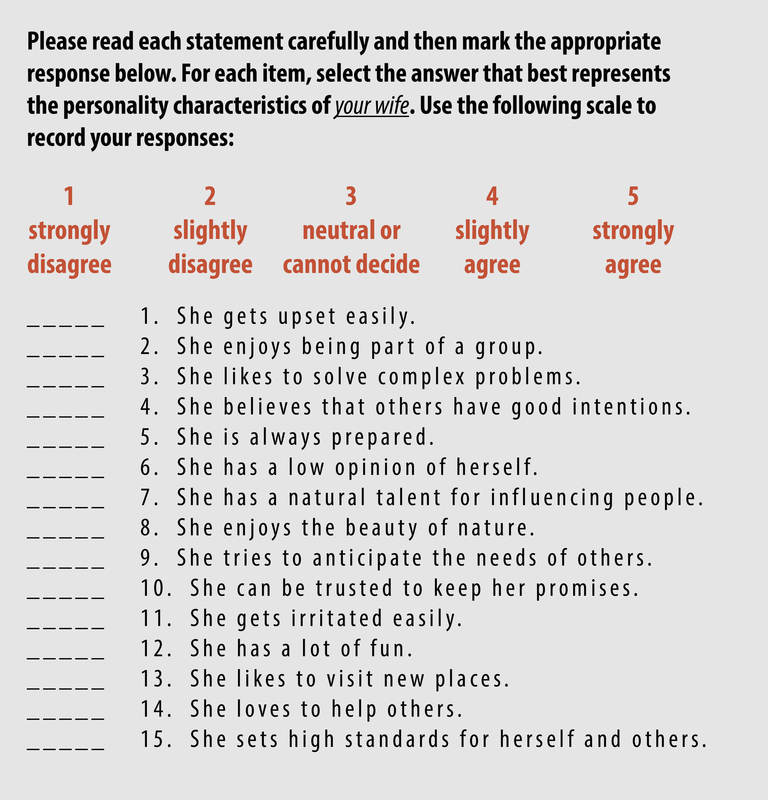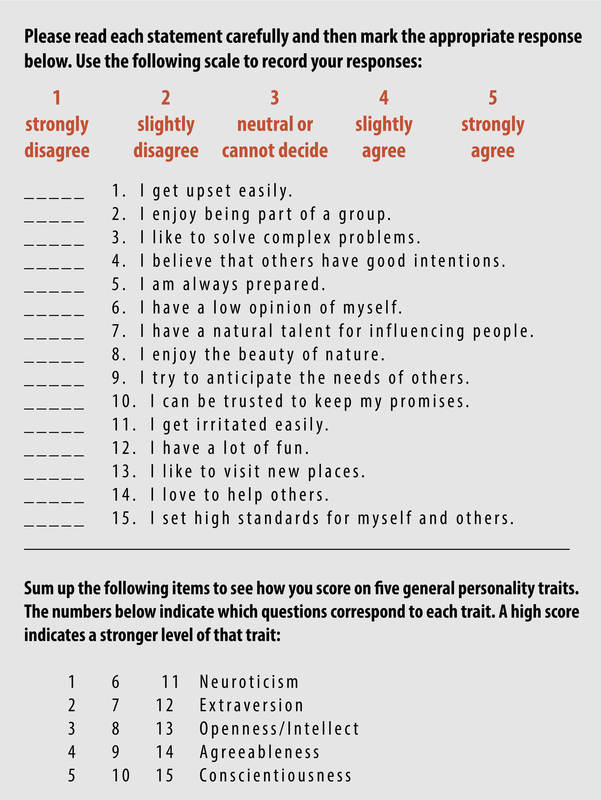8.2 Measuring Personality
Objective Tests
Objective tests (Loevinger, 1957; Meyer & Kurtz, 2006) represent the most familiar and widely used approach to assessing personality. Objective tests involve administering a standard set of items, each of which is answered using a limited set of response options (e.g., true or false; strongly disagree, slightly disagree, slightly agree, strongly agree). Responses to these items then are scored in a standardized, predetermined way. For example, self-ratings on items assessing talkativeness, assertiveness, sociability, adventurousness, and energy can be summed up to create an overall score on the personality trait of extraversion.
It must be emphasized that the term “objective” refers to the method that is used to score a person’s responses, rather than to the responses themselves. As noted by Meyer and Kurtz (2006), “What is objective about such a procedure is that the psychologist administering the test does not need to rely on judgment to classify or interpret the test-taker’s response; the intended response is clearly indicated and scored according to a pre-existing key” (p. 233). In fact, as we will see, a person’s test responses may be highly subjective and can be influenced by a number of different rating biases.
Information from objective tests can be gathered in two ways: through self-report, in which participants reflect on their own personality, or by using ratings from informants.
Self-report measures
Objective personality tests can be further subdivided into two basic types. The first type—which easily is the most widely used in modern personality research—asks people to describe themselves. This approach offers two key advantages. First, self-raters have access to an unparalleled wealth of information: After all, who knows more about you than you yourself? In particular, self-raters have direct access to their own thoughts, feelings, and motives, which may not be readily available to others (Oh et al., 2011; Watson et al., 2000). Second, asking people to describe themselves is the simplest, easiest, and most cost-effective approach to assessing personality. Countless studies, for instance, have involved administering self-report measures to college students, who are provided with some relatively simple incentive (e.g., extra course credit) to participate.
The items included in self-report measures may consist of single words (e.g., assertive), short phrases (e.g., am full of energy), or complete sentences (e.g., I like to spend time with others). Table 1 presents a sample self-report measure assessing the general traits comprising the influential five-factor model (FFM) of personality: neuroticism, extraversion, openness, agreeableness, and conscientiousness (John & Srivastava, 1999; McCrae et al., 2005). The sentences shown in Table 1 are modified versions of items included in the International Personality Item Pool (IPIP) (Goldberg et al., 2006), which is a rich source of personality-related content in the public domain (for more information about IPIP, go to:International Personality Item Pool).

Image Description
Figure 8.2 shows a sample informant-report personality questionnaire. The instructions ask the rater to read each statement and choose how well it describes the personality characteristics of “your wife,” using a 1–5 Likert scale where 1 = strongly disagree, 2 = slightly disagree, 3 = neutral or cannot decide, 4 = slightly agree, and 5 = strongly agree. Fifteen statements follow, each with a blank line for entering the rating. The items describe traits such as: gets upset easily, enjoys being part of a group, likes solving complex problems, believes others have good intentions, is always prepared, has a low opinion of herself, has a natural talent for influencing people, enjoys nature, anticipates others’ needs, can be trusted to keep promises, gets irritated easily, has a lot of fun, likes to visit new places, loves to help others, and sets high standards for herself and others.
Self-report personality tests show impressive validity in relation to a wide range of important outcomes. For example, self-ratings of conscientiousness are significant predictors of both overall academic performance (e.g., cumulative grade point average; Poropat, 2009) and job performance (Oh et al., 2011). Roberts et al. (2007) reported that self-rated personality predicted occupational attainment, divorce, and mortality. Similarly, Friedman et al. (2010) showed that personality ratings collected early in life were related to happiness/well-being, physical health, and mortality risk assessed several decades later. Finally, self-reported personality has important and pervasive links to psychopathology. Most notably, self-ratings of neuroticism are associated with a wide array of clinical syndromes, including anxiety disorders, depressive disorders, substance use disorders, somatoform disorders, eating disorders, personality and conduct disorders, and schizophrenia/schizotypy (Kotov et al., 2010; Mineka et al., 1998).
At the same time, however, it is clear that this method is limited in a number of ways. First, raters may be motivated to present themselves in an overly favourable, socially desirable way (Paunonen & LeBel, 2012). This is a particular concern in “high-stakes testing,” that is, situations in which test scores are used to make important decisions about individuals (e.g., when applying for a job). Second, personality ratings reflect a self-enhancement bias (Vazire & Carlson, 2011); in other words, people are motivated to ignore (or at least downplay) some of their less desirable characteristics and to focus instead on their more positive attributes. Third, self-ratings are subject to the reference group effect (Heine et al., 2008); that is, we base our self-perceptions, in part, on how we compare to others in our sociocultural reference group. For instance, if you tend to work harder than most of your friends, you will see yourself as someone who is relatively conscientious, even if you are not particularly conscientious in any absolute sense.
Informant Ratings
Rather than have someone self-report, another approach is to ask someone who knows a person well to describe their personality characteristics. In the case of children or adolescents, the informant is most likely to be a parent or teacher. In studies of older participants, informants may be friends, roommates, dating partners, spouses, children, or bosses (Oh et al., 2011; Vazire & Carlson, 2011; Watson et al., 2000).
Generally speaking, informant ratings are similar in format to self-ratings. As was the case with self-report, items may consist of single words, short phrases, or complete sentences. Indeed, many popular instruments include parallel self- and informant-rating versions, and it is often relatively easy to convert a self-report measure so that it can be used to obtain informant ratings. Table 2 illustrates how the self-report instrument shown in Table 1 can be converted to obtain spouse ratings (in this case, having a husband describe the personality characteristics of his wife).

Image Description
Figure 8.3 shows a sample self-report personality questionnaire. The instructions ask the person to read each statement and mark how well it describes them using a 1–5 Likert scale, where 1 = strongly disagree, 2 = slightly disagree, 3 = neutral or cannot decide, 4 = slightly agree, and 5 = strongly agree. Fifteen items are listed with a blank line before each:
- I get upset easily.
- I enjoy being part of a group.
- I like to solve complex problems.
- I believe that others have good intentions.
- I am always prepared.
- I have a low opinion of myself.
- I have a natural talent for influencing people.
- I enjoy the beauty of nature.
- I try to anticipate the needs of others.
- I can be trusted to keep my promises.
- I get irritated easily.
- I have a lot of fun.
- I like to visit new places.
- I love to help others.
- I set high standards for myself and others.
A scoring key at the bottom explains that responses are summed to create scores on five personality traits: items 1, 6, and 11 = Neuroticism; items 2, 7, and 12 = Extraversion; items 3, 8, and 13 = Openness/Intellect; items 4, 9, and 14 = Agreeableness; and items 5, 10, and 15 = Conscientiousness. A higher summed score indicates a stronger level of that trait.
Informant ratings are particularly valuable when self-ratings are impossible to collect (e.g., when studying young children or cognitively impaired adults) or when their validity is suspect (e.g., as noted earlier, people may not be entirely honest in high-stakes testing situations). They also may be combined with self-ratings of the same characteristics to produce more reliable and valid measures of these attributes (McCrae, 1994).

Informant ratings offer several advantages in comparison to other approaches to assessing personality. A well-acquainted informant presumably has had the opportunity to observe large samples of behaviour in the person he or she is rating. Moreover, these judgments presumably are not subject to the types of defensiveness that potentially can distort self-ratings (Vazire & Carlson, 2011). Indeed, informants typically have strong incentives for being accurate in their judgments. As Funder and Dobroth (1987), put it, “Evaluations of the people in our social environment are central to our decisions about who to befriend and avoid, trust and distrust, hire and fire, and so on” (p. 409).
Informant personality ratings have demonstrated a level of validity in relation to important life outcomes that is comparable to that discussed earlier for self-ratings. Indeed, they outperform self-ratings in certain circumstances, particularly when the assessed traits are highly evaluative in nature (e.g., intelligence, charm, creativity; see Vazire & Carlson, 2011). For example, Oh et al. (2011) found that informant ratings were more strongly related to job performance than were self-ratings. Similarly, Oltmanns and Turkheimer (2009) summarized evidence indicating that informant ratings of Air Force cadets predicted early, involuntary discharge from the military better than self-ratings.
Nevertheless, informant ratings are also subject to certain problems and limitations. One general issue is the level of relevant information that is available to the rater (Funder, 2012). For instance, even under the best of circumstances, informants lack full access to the thoughts, feelings, and motives of the person they are rating. This problem is magnified when the informant does not know the person particularly well and/or only sees him or her in a limited range of situations (Funder, 2012; Beer & Watson, 2010).
Informant ratings are also subject to some of the same response biases noted earlier for self-ratings. For instance, they are not immune to the reference group effect. Indeed, it is well-established that parent ratings often are subject to a sibling contrast effect, such that parents exaggerate the true magnitude of differences between their children (Pinto et al., 2012). Furthermore, in many studies, individuals are allowed to nominate (or even recruit) the informants who will rate them. Because of this, it most often is the case that informants (who, as noted earlier, may be friends, relatives, or romantic partners) like the people they are rating. This, in turn, means that informants may produce overly favourable personality ratings. Indeed, their ratings actually can be more favourable than the corresponding self-ratings (Watson & Humrichouse, 2006). This tendency for informants to produce unrealistically positive ratings has been termed the letter of recommendation effect (Leising et al., 2010) and the honeymoon effect when applied to newlyweds (Watson & Humrichouse, 2006).
Projective and Implicit Tests
Some approaches to personality assessment are based on the belief that important thoughts, feelings, and motives operate outside of conscious awareness. Two ways to assess these nonconscious influences on personality are through projective and implicit tests.
Projective Tests
Projective tests represent influential early examples of this approach. Projective tests originally were based on the projective hypothesis (Frank, 1939; Lilienfeld et al., 2000): If a person is asked to describe or interpret ambiguous stimuli—that is, things that can be understood in a number of different ways—their responses will be influenced by nonconscious needs, feelings, and experiences (note, however, that the theoretical rationale underlying these measures has evolved over time) (see, for example, Spangler, 1992). Two prominent examples of projective tests are the Rorschach Inkblot Test (Rorschach, 1921) and the Thematic Apperception Test (TAT) (Morgan & Murray, 1935). The former asks respondents to interpret symmetrical blots of ink, whereas the latter asks them to generate stories about a series of pictures.

Image Description
Figure 8.4 shows a dark brown, symmetrical Rorschach-style inkblot on a white background, with irregular mirrored shapes that can be interpreted in many ways, illustrating an ambiguous stimulus used in projective personality tests.
In comparison to objective tests, projective tests tend to be somewhat cumbersome and labour-intensive to administer. The biggest challenge, however, has been to develop a reliable and valid scheme to score the extensive set of responses generated by each respondent. The most widely used Rorschach scoring scheme is the Comprehensive System developed by Exner (2003). The most influential TAT scoring system was developed by McClelland, Atkinson and colleagues between 1947 and 1953 (McClelland et al., 1989; see also Winter, 1998), which can be used to assess motives such as the need for achievement.
The validity of the Rorschach has been a matter of considerable controversy (Lilienfeld et al., 2000; Mihura et al., 2012; Society for Personality Assessment, 2005). Most reviews acknowledge that Rorschach scores do show some ability to predict important outcomes. Its critics, however, argue that it fails to provide important incremental information beyond other, more easily acquired information, such as that obtained from standard self-report measures (Lilienfeld et al., 2000).
Validity evidence is more impressive for the TAT. In particular, reviews have concluded that TAT-based measures of the need for achievement (a) show significant validity to predict important criteria and (b) provide important information beyond that obtained from objective measures of this motive (McClelland et al., 1989; Spangler, 1992). Furthermore, given the relatively weak associations between objective and projective measures of motives, McClelland et al. (1989) argue that they tap somewhat different processes, with the latter assessing implicit motives (Schultheiss, 2008).
Implicit Tests
In recent years, researchers have begun to use implicit measures of personality (Back et al., 2009; Vazire & Carlson, 2011). These tests are based on the assumption that people form automatic or implicit associations between certain concepts based on their previous experience and behaviour. If two concepts (e.g., me and assertive) are strongly associated with each other, then they should be sorted together more quickly and easily than two concepts (e.g., me and shy) that are less strongly associated. Although validity evidence for these measures is still relatively sparse, the results to date are encouraging: Back et al. (2009), for example, showed that implicit measures of the FFM personality traits predicted behaviour even after controlling for scores on objective measures of these same characteristics.
Behavioral Tests

A final approach is to infer important personality characteristics from direct samples of behaviour. For example, Funder and Colvin (1988) brought opposite-sex pairs of participants into the laboratory and had them engage in a five-minute “getting acquainted” conversation; raters watched videotapes of these interactions and then scored the participants on various personality characteristics. Mehl et al. (2006) used the electronically activated recorder (EAR) to obtain samples of ambient sounds in participants’ natural environments over a period of two days; EAR-based scores then were related to self- and observer-rated measures of personality. For instance, more frequent talking over this two-day period was significantly related to both self- and observer-ratings of extraversion. As a final example, Gosling et al. (2002) sent observers into college students’ bedrooms and then had them rate the students’ personality characteristics on the Big Five traits. The averaged observer ratings correlated significantly with participants’ self-ratings on all five traits. Follow-up analyses indicated that conscientious students had neater rooms, whereas those who were high in openness to experience had a wider variety of books and magazines.
Behavioural measures offer several advantages over other approaches to assessing personality. First, because behaviour is sampled directly, this approach is not subject to the types of response biases (e.g., self-enhancement bias, reference group effect) that can distort scores on objective tests. Second, as is illustrated by the Mehl et al. (2006) and Gosling et al. (2002) studies, this approach allows people to be studied in their daily lives and in their natural environments, thereby avoiding the artificiality of other methods (Mehl et al., 2006). Finally, this is the only approach that actually assesses what people do, as opposed to what they think or feel (see Baumeister et al., 2007).
At the same time, however, this approach also has some disadvantages. This assessment strategy clearly is much more cumbersome and labour-intensive than using objective tests, particularly self-report. Moreover, similar to projective tests, behavioral measures generate a rich set of data that then needs to be scored in a reliable and valid way. Finally, even the most ambitious study only obtains relatively small samples of behaviour that may provide a somewhat distorted view of a person’s true characteristics. For example, your behaviour during a “getting acquainted” conversation on a single given day inevitably will reflect a number of transient influences (e.g., level of stress, quality of sleep the previous night) that are idiosyncratic to that day.
Personality Testing in Employee Selection
Personality is a potentially important predictor of work behaviour. Matching people to jobs matters because when people do not fit with their jobs or the company, they are more likely to leave, costing companies as much as a person’s annual salary to replace them. In job interviews, companies try to assess a candidate’s personality and the potential for a good match, but interviews are only as good as the people conducting them. In fact, interviewers are not particularly good at detecting the best trait that predicts performance: conscientiousness (Barrick et al., 2000). One method some companies use to improve this match and detect the people who are potentially good job candidates is personality testing. Companies such as Kronos and Hogan Assessment Systems conduct pre-employment personality tests. Companies using them believe that these tests improve the effectiveness of their selection and reduce turnover. For example, Overnight Transportation in Atlanta found that using such tests reduced their on-the-job delinquency by 50%–100% (Emmet, 2004; Gale, 2002).
Yet, are these methods good ways of selecting employees? Experts have not yet reached an agreement on this subject and the topic is highly controversial. Some experts believe, based on data, that personality tests predict performance and other important criteria, such as job satisfaction. However, we must understand that how a personality test is used influences its validity. Imagine filling out a personality test in class. You may be more likely to fill it out as honestly as you can. Then, if your instructor correlates your personality scores with your class performance, we could say that the correlation is meaningful. In employee selection, one complicating factor is that people filling out the survey do not have a strong incentive to be honest. In fact, they have a greater incentive to guess what the job requires and answer the questions to match what they think the company is looking for. As a result, the rankings of the candidates who take the test may be affected by their ability to fake. Some experts believe that this is a serious problem(Morgeson et al., 2007; Morgeson et al., 2007). Others point out that even with faking, the tests remain valid—the scores are still related to job performance (Barrick & Mount, 1996; Ones et al., 2007; Ones et al., 1996; Tett & Christiansen, 2007). It is even possible that the ability to fake is related to a personality trait that increases success at work, such as social monitoring. This issue raises potential questions regarding whether personality tests are the most effective way of measuring candidate personality.
Scores are not only distorted because of some candidates faking better than others. Do we even know our own personality? Are we the best people to ask this question? How supervisors, coworkers, and customers see our personality matters more than how we see ourselves. Therefore, using self-report measures of performance may not be the best way of measuring someone’s personality (Mount et al., 1994). We all have blind areas. We may also give “aspirational” answers. If you are asked if you are honest, you may think, “Yes, I always have the intention to be honest.” This response says nothing about your actual level of honesty.
There is another problem with using these tests: How good a predictor of performance is personality anyway? Based on research, not a particularly strong one. According to one estimate, personality only explains about 10%–15% of the variation in job performance. Our performance at work depends on so many factors, and personality does not seem to be the key factor for performance. In fact, cognitive ability (your overall mental intelligence) is a much more powerful influence on job performance, and instead of personality tests, cognitive ability tests may do a better job of predicting who will be good performers. Personality is a better predictor of job satisfaction and other attitudes, but screening people out on the assumption that they may be unhappy at work is a challenging argument to make in the context of employee selection.
In any case, if you decide to use these tests for selection, you need to be aware of their limitations. Relying only on personality tests for the selection of an employee is a bad idea, but if they are used together with other tests, such as tests of cognitive abilities, better decisions may be made. The company should ensure that the test fits the job and actually predicts performance. This process is called validating the test. Before giving the test to applicants, the company could give it to existing employees to find out the traits that are most important for success in the particular company and job. Then, in the selection context, the company can pay particular attention to those traits. The company should also make sure that the test does not discriminate against people on the basis of sex, race, age, disability, or other legally protected characteristics. Rent-A-Center experienced legal difficulties when the test they used was found to be a violation of the Americans with Disabilities Act (ADA). The test they used for selection, the Minnesota Multiphasic Personality Inventory, was developed to diagnose severe mental illnesses and included items such as “I see things or people around me that others do not see.” In effect, the test served the purpose of a clinical evaluation and discriminated against people with mental illnesses, which is a protected category under ADA (Heller, 2005). Similarly, employers in Ontario need to use personality tests with caution and the use of these tests should not result in direct or indirect discrimination of groups protected by the Ontario Human Rights Code (OHRC, 2008).
Let’s Review
No single method of assessing personality is perfect or infallible; each of the major methods has both strengths and limitations. By using a diversity of approaches, researchers can overcome the limitations of any single method and develop a more complete and integrative view of personality. Employers should use personality testing with caution.
 Exercises
Exercises
- Under what conditions would you expect self-ratings to be most similar to informant ratings? When would you expect these two sets of ratings to be most different from each other?
- The findings of Gosling et al. (2002) demonstrate that we can obtain important clues about students’ personalities from their dorm rooms. What other aspects of people’s lives might give us important information about their personalities?
- Suppose that you were planning to conduct a study examining the personality trait of honesty. What method or methods might you use to measure it?
References
This section is adapted from:
Personality Assessment by David Watson is licensed under a Creative Commons Attribution-NonCommercial-ShareAlike 4.0 International License.
Organizational Behaviour by Seneca College is licensed under a Creative Commons Attribution-NonCommercial 4.0 International License, except where otherwise noted.
Back, M. D., Schmukle, S. C., & Egloff, B. (2009). Predicting actual behavior from the explicit and implicit self-concept of personality. Journal of Personality and Social Psychology, 97, 533–548.
Barrick, M. R., & Mount, M. K. (1996). Effects of impression management and self-deception on the predictive validity of personality constructs. Journal of Applied Psychology, 81, 261–272.
Barrick, M. R., Patton, G. K., & Haugland, S. N. (2000). Accuracy of interviewer judgments of job applicant personality traits. Personnel Psychology, 53(4), 925–951.
Baumeister, R. F., Vohs, K. D., & Funder, D. C. (2007). Psychology as the science of self-reports and finger movements: Whatever happened to actual behavior? Perspectives on Psychological Science, 2, 396–403.
Beer, A., & Watson, D. (2010). The effects of information and exposure on self-other agreement. Journal of Research in Personality, 44, 38–45.
Emmett, A. (2004). Snake oil or science? That’s the raging debate on personality testing. Workforce Management, 83, 90–92.
Exner, J. E. (2003). The Rorschach: A comprehensive system (4th ed.). Wiley.
Frank, L. K. (1939). Projective methods for the study of personality. Journal of Psychology: Interdisciplinary and Applied, 8, 389–413.
Friedman, H. S., Kern, K. L., & Reynolds, C. A. (2010). Personality and health, subjective well-being, and longevity. Journal of Personality, 78, 179–215.
Funder, D. C. (2012). Accurate personality judgment. Current Directions in Psychological Science, 21, 177–182.
Funder, D. C., & Colvin, C. R. (1988). Friends and strangers: Acquaintanceship, agreement, and the accuracy of personality judgment. Journal of Personality and Social Psychology, 55, 149–158.
Funder, D. C., & Dobroth, K. M. (1987). Differences between traits: Properties associated with interjudge agreement. Journal of Personality and Social Psychology, 52, 409–418.
Gale, S. F. (2002). Three companies cut turnover with tests. Workforce, 81(4), 66–69.
Goldberg, L. R., Johnson, J. A., Eber, H. W., Hogan, R., Ashton, M. C., Cloninger, C. R., & Gough, H. C. (2006). The International Personality Item Pool and the future of public-domain personality measures. Journal of Research in Personality, 40, 84–96.
Gosling, S. D., Ko, S. J., Mannarelli, T., & Morris, M. E. (2002). A room with a cue: Personality judgments based on offices and bedrooms. Journal of Personality and Social Psychology, 82, 379–388.
Heine, S. J., Buchtel, E. E., & Norenzayan, A. (2008). What do cross-national comparisons of personality traits tell us? The case of conscientiousness. Psychological Science, 19, 309–313.
Heller, M. (2005). Court ruling that employer’s integrity test violated ADA could open door to litigation. Workforce Management, 84(9), 74–77.
John, O. P., & Srivastava, S. (1999). The big five trait taxonomy: History, measurement, and theoretical perspectives. In L. A. Pervin & O. P. John (Eds.), Handbook of personality: Theory and research (2nd ed., pp. 102–138). The Guilford Press.
Kotov, R., Gamez, W., Schmidt, F., & Watson, D. (2010). Linking “big” personality traits to anxiety, depressive, and substance use disorders: A meta-analysis. Psychological Bulletin, 136, 768–821.
Leising, D., Erbs, J., & Fritz, U. (2010). The letter of recommendation effect in informant ratings of personality. Journal of Personality and Social Psychology, 98, 668–682.
Lilienfeld, S. O., Wood, J. M., & Garb, H. N. (2000). The scientific status of projective techniques. Psychological Science in the Public Interest, 1, 27–66.
Loevinger, J. (1957). Objective tests as instruments of psychological theory. Psychological Reports, 3, 635–694.
McClelland, D. C., Koestner, R., & Weinberger, J. (1989). How do self-attributed and implicit motives differ? Psychological Review, 96, 690–702.
McCrae, R. R. (1994). The counterpoint of personality assessment: Self-reports and observer ratings. Assessment, 1, 159–172.
McCrae, R. R., Costa, P. T., Jr., & Martin, T. A. (2005). The NEO-PI-3: A more readable Revised NEO Personality Inventory. Journal of Personality Assessment, 84, 261–270..
Mehl, M. R., Gosling, S. D., & Pennebaker, J. W. (2006). Personality in its natural habitat: Manifestations and implicit folk theories of personality in daily life. Journal of Personality and Social Psychology, 90, 862–877.
Meyer, G. J., & Kurtz, J. E. (2006). Advancing personality assessment terminology: Time to retire “objective” and “projective” as personality test descriptors. Journal of Personality Assessment, 87, 223–225.
Mihura, J. L., Meyer, G. J., Dumitrascu, N., & Bombel, G. (2012). The validity of individual Rorschach variables: Systematic Reviews and meta-analyses of the Comprehensive System. Psychological Bulletin. (Advance online publication.) doi:10.1037/a0029406
Mineka, S., Watson, D., & Clark, L. A. (1998). Comorbidity of anxiety and unipolar mood disorders. Annual Review of Psychology, 49, 377–412.
Morgan, C. D., & Murray, H. A. (1935). A method for investigating fantasies. The Archives of Neurology and Psychiatry, 34, 389–406.
Morgeson, F. P., Campion, M. A., Dipboye, R. L., Hollenbeck, J. R., Murphy, K., & Schmitt, N. (2007). Are we getting fooled again? Coming to terms with limitations in the use of personality tests for personnel selection. Personnel Psychology, 60, 1029–1049.
Morgeson, F. P., Campion, M. A., Dipboye, R. L., Hollenbeck, J. R., Murphy, K., & Schmitt, N. (2007). Reconsidering the use of personality tests in personnel selection contexts. Personnel Psychology, 60, 683–729.
Mount, M. K., Barrick, M. R., & Strauss, J. P. (1994). Validity of observer ratings of the Big Five personality factors. Journal of Applied Psychology, 79, 272–280.
Oh, I.-S., Wang, G., & Mount, M. K. (2011). Validity of observer ratings of the five-factor model of personality traits: A meta-analysis. Journal of Applied Psychology, 96, 762–773.
Oltmanns, T. F., & Turkheimer, E. (2009). Person perception and personality pathology. Current Directions in Psychological Science, 18, 32–36.
Ontario Human Rights Commission. (2008). Requesting job-related sensitive information. Human Rights at Work. https://www.ohrc.on.ca/en/iv-human-rights-issues-all-stages-employment/6-requesting-job-related-sensitive-information
Ones, D. S., Dilchert, S., Viswesvaran, C., & Judge, T. A. (2007). In support of personality assessment in organizational settings. Personnel Psychology, 60, 995–1027.
Ones, D. S., Viswesvaran, C., & Reiss, A. D. (1996). Role of social desirability in personality testing for personnel selection. Journal of Applied Psychology, 81, 660–679.
Paunonen, S. V., & LeBel, E. P. (2012). Socially desirable responding and its elusive effects on the validity of personality assessments. Journal of Personality and Social Psychology, 103, 158–175.
Pinto, R., Rijsdijk, F., Frazier-Wood, A. C., Asherson, P., & Kuntsi, J. (2012). Bigger families fare better: A novel method to estimate rater contrast effects in parental ratings on ADHD symptoms. Behavior Genetics, 42, 875–885.
Poropat, A. E. (2009). A meta-analysis of the five-factor model of personality and academic performance. Psychological Bulletin, 135, 322–338.
Roberts, B. W., Kuncel, N. R., Shiner, R., Caspi, A., & Goldberg, L. R. (2007). The power of personality: The comparative validity of personality traits, socioeconomic status, and cognitive ability for predicting important life outcomes. Perspectives on Psychological Science, 2, 313–345.
Rorschach, H. (1942) (Original work published 1921). Psychodiagnostik [Psychodiagnostics]. Bern, Switzerland: Bircher.
Schultheiss, O. C. (2008). Implicit motives. In O. P. John, R. W. Robins, & L. A. Pervin (Eds.), Handbook of personality: Theory and research (3rd ed., pp. 603–633). Guilford Press.
Society for Personality Assessment. (2005). The status of the Rorschach in clinical and forensic practice: An official statement by the Board of Trustees of the Society for Personality Assessment. Journal of Personality Assessment, 85, 219–237.
Spangler, W. D. (1992). Validity of questionnaire and TAT measures of need for achievement: Two meta-analyses. Psychological Bulletin, 112, 140–154.
Tett, R. P., & Christiansen, N. D. (2007). Personality tests at the crossroads: A response to Morgeson, Campion, Dipboye, Hollenbeck, Murphy, and Schmitt (2007). Personnel Psychology, 60, 967–993.
Vazire, S., & Carlson, E. N. (2011). Others sometimes know us better than we know ourselves. Current Directions in Psychological Science, 20, 104–108.
Watson, D., & Humrichouse, J. (2006). Personality development in emerging adulthood: Integrating evidence from self- and spouse-ratings. Journal of Personality and Social Psychology, 91, 959–974.
Watson, D., Hubbard, B., & Wiese, D. (2000). Self-other agreement in personality and affectivity: The role of acquaintanceship, trait visibility, and assumed similarity. Journal of Personality and Social Psychology, 78, 546–558.
Winter, D. G. (1998). Toward a science of personality psychology: David McClelland’s development of empirically derived TAT measures. History of Psychology, 1, 130–153.

